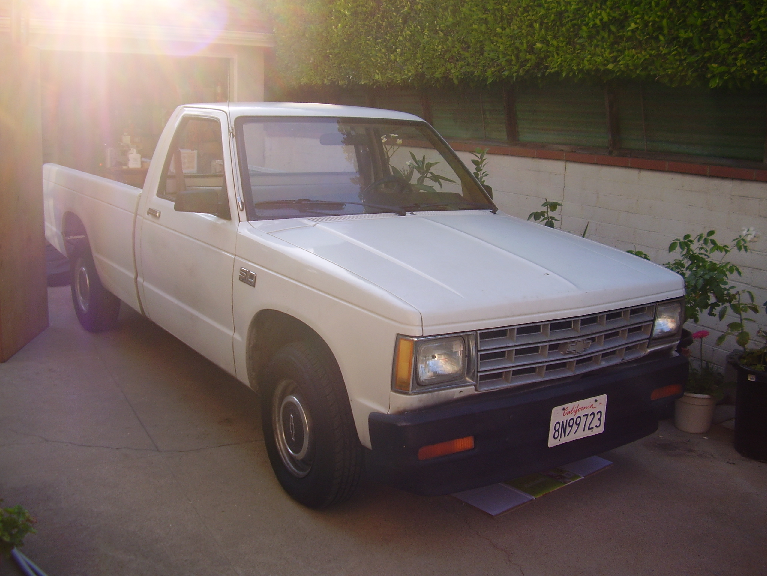

 |

EV Conversion Details for El Ohmbre™ Electric Vehicle Conversion Project |
EV Conversion Project DetailsI had many questions when I started my EV conversion project. One of the first was how difficult is an electric vehicle conversion. Next I wondered what type of car to use and then I wondered what parts would I need. I also wondered where I could get good advice which is partly why I made this website about my EV conversion.Level of DifficultyI'm pretty handy but I didn't have access to a machine shop. I only had the hand tools in my garage. I was able to borrow what I didnt' have and the project was moderately difficult for me. I spent about 250 hours over eight months. That is basically eight months of Saturdays with a few weekday evenings. This doesn't count the planning process.The Donor CarMy initial plan was to build a sports car that would be fun to drive. However, after doing some investigation I learned that it might be easier to do a Ford Ranger or Chevrolet S-10 Pickup. I also learned that the car is called a "donor car" for reasons I can only guess. I began looking for a suitable Ford Ranger or Chevy S-10. It happens that I found several of each brand but the car I chose was a 1985 Chevrolet S-10 Pickup with over 270,000 miles on it. It look reasonably OK from the outside but closer inspection showed that it had probably been damaged and put back together.The good thing about this particular Chevy S-10 was that it was actually still running. I could drive it and test the transmission, rear end, brakes, steering, suspension and other minor systems before making the final decision. I paid a bit more that I would have to buy a car that wasn't running but I thought it would be worth it. Another interesting fact about the S-10 is that Chevrolet actually made an electric version in 1997 and 1998. I also picked a car with no power brakes or power steering that would have to be removed or converted to use with the electric motor. In hindsight, after two years of driving my EV conversion, I would have picked a better donor care if I had known it was going to work so well. However, I'm happy with my decision and the Chevy S-10 worked out well for me. EV Conversion PartsOne important lesson I learned is that I needed to keep a list of the major parts handy to copy and paste into emails and forum posts. Many questions about the EV conversion need information about the electric motor, power controller and battery pack.Here is the list of major components: FB1-4001A Advanced DC Motor with dual shaft 1231C-8601 Curtis Controller Elcon PFC 3000 Charger Dual Voltage Trojan T-145 Batteries (20) EV BatteriesBatteries, of course are one of the most important components in an electric vehicle. I chose to use 20 Trojan T-145 batteries because I heard they would be the best for an electric vehicle conversion. I was able to get a deal on buying 20 batteries and I ended up paying about $150 per battery for a total of around $3,000 making the traction battery pack the single most expensive component in my EV conversion.I spent quite a bit of time with the engineer at Trojan Battery Company who explained a few of the technical details to me. I decided to go with 20 batteries for a total of 120 volts rather than using 24 batteries for 144 volts. This decision was made mainly on space and weight restrictions. Trojan has the specifications for their batteries posted on their site. My completed EV conversion weighs 4,200 pounds and without power brakes it's a challenge to stop. I try to maintain a nice safe distance from the car in front of me and I watch traffic signals very carefully so I don't have to make short stops as much as possible. An extra four batteries would have increased the overall weight by another 270 pounds. I wanted to keep the traction pack out of sight too. I have four batteries in front where the original radiator used to be and the other 16 batteries are under the pickup bed. I made the bed tilt to give access to the batteries for regular battery maintenance. EV MotorAs noted above, I chose the FB1-4001A Advanced DC Motor with dual shaft. I'd like to say that I did a lot of detailed investigation and calculations to arrive at this choice but I didn't. I basically did a bunch of Internet searches and found that this motor and the Warp-9 seemed to be about the two most commonly used in EV conversions similar to mine. This motor was recommended to me by Bob at EV America where I bought most of the parts.In my experience it seems that most dealers of EV conversion parts sell either the Advanced DC Motor or the Warp-9 motor but not both. Maybe if there are dealers out there who sell both, they could contact me and I'll add their name to my links page. It would be interesting to hear from someone who sells both about the best features of each motor. I have had no problem with my Advanced DC Motor other than the relatively low range I get. I have no idea if that is due in any way to the motor or not. There are two wires that signal a high internal motor temperature that I have never hooked up. It's on my list of things to do but just hasn't risen to the top yet. |